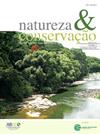概念系统图用于指导多种生态系统服务和危害的研究和管理
IF 3.5
2区 环境科学与生态学
Q1 BIODIVERSITY CONSERVATION
引用次数: 0
摘要
需要对多种自然资本和生态系统服务与危害(ESD)进行综合评估,以指导南美洲的研究和管理。不幸的是,对ESD驱动因素的理解不足和数据的缺乏破坏了这些努力。在这里,我们结合专家知识和网络分析来创建概念系统图,以支持多个ESD的研究和管理。以Lules河流域(阿根廷西北部)为例,我们综合了五个可持续发展生态系统的生物、非生物、社会经济和政策驱动因素,因为它们与该地区的人类福祉和生物多样性保护相关:(i)地上碳储量;(ii)水质;(三)水量;登革热传播;(五)利什曼病传播。通过促进活动,我们将专业知识编码为代表驱动因素和这些驱动因素之间因果关系的网络。我们记录了43个驱动因素,其中18个被确定为基于网络指标的关键驱动因素。大多数关键驱动因素是非生物和社会经济驱动因素(分别为38.9%和33.3%),我们发现了所有这些关键驱动因素的潜在信息源。概念系统图为指导ESD研究和基于生态系统的管理提供了显著的好处。首先,他们形式化了我们目前对系统的理解,并提供了一个可以用新信息更新的模型。其次,它们可以通过已建立的网络指标进行分析,以揭示对有效的系统级管理至关重要的关系,并确定数据收集工作的关键驱动因素。这些地图提供了一种快速和跨学科的工具,以克服在数据贫乏地区进行综合评估的现有障碍,并且是支持基于系统的环境管理方法的有力方法。本文章由计算机程序翻译,如有差异,请以英文原文为准。

Conceptual system maps to guide research and management of multiple ecosystem services and disservices
Integrated assessments of multiple natural capital and ecosystem services and disservices (ESD) are needed to guide research and management in South America. Unfortunately, a poor understanding of the drivers of ESD and a scarcity of data undermine these efforts. Here, we combine expert knowledge and network analyses to create conceptual system maps to support the research and management of multiple ESD. Using the example of the Lules River watershed (northwestern Argentina), we integrated the biotic, abiotic, socio-economic, and policy drivers of five ESD selected due to their relevance to human well-being and biodiversity conservation in the area: (i) aboveground carbon stock; (ii) water quality; (iii) water quantity; (iv) dengue transmission; and (v) leishmaniasis transmission. Through facilitated activities, we encoded expert knowledge into networks representing drivers and causal interactions between those drivers. We recorded 43 drivers, of which 18 were identified as key drivers based on network metrics. The majority of key drivers were abiotic and socio-economic drivers (38.9% and 33.3% of 18, respectively), and we found potential information sources for all of these key drivers. Conceptual system maps provided significant benefits for guiding ESD research and ecosystem-based management. First, they formalised our current understanding of the system and provided a model that can be updated with new information. Second, they can be analysed through established network metrics to uncover relationships critical to effective system-level management and identify key drivers for data-gathering efforts. These maps offer a rapid and interdisciplinary tool to overcome existing barriers to integrated assessments in data-poor areas and are a powerful method to support system-based approaches to environmental management.
求助全文
通过发布文献求助,成功后即可免费获取论文全文。
去求助
来源期刊

Perspectives in Ecology and Conservation
Environmental Science-Nature and Landscape Conservation
CiteScore
7.80
自引率
4.30%
发文量
46
审稿时长
59 days
期刊介绍:
Perspectives in Ecology and Conservation (PECON) is a scientific journal devoted to improving theoretical and conceptual aspects of conservation science. It has the main purpose of communicating new research and advances to different actors of society, including researchers, conservationists, practitioners, and policymakers. Perspectives in Ecology and Conservation publishes original papers on biodiversity conservation and restoration, on the main drivers affecting native ecosystems, and on nature’s benefits to people and human wellbeing. This scope includes studies on biodiversity patterns, the effects of habitat loss, fragmentation, biological invasion and climate change on biodiversity, conservation genetics, spatial conservation planning, ecosystem management, ecosystem services, sustainability and resilience of socio-ecological systems, conservation policy, among others.
 求助内容:
求助内容: 应助结果提醒方式:
应助结果提醒方式:


